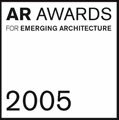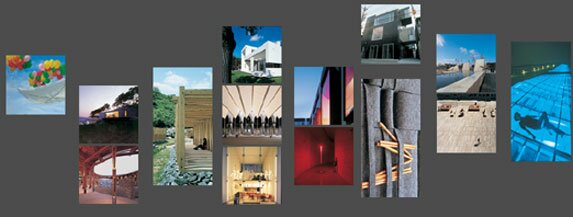

2002
2001
press release 2001
winners 2001
entrants 2001 pdf
winners comments 2001
jury 2001
2000
winners 2000
the event 2000
1999
winners 1999
jury 1999
ar+d partners worldwide
for your local ar+d representative
architectural review
Buro Happold
An impressive array of architects and designers from all over the world were congregated in the recently erected Danish Design Centre in the heart of Copenhagen on 29 November. The occasion? The celebration of this years winners of the worlds only competition for emerging architecture the ar+d. Both competition and ceremony were hosted by The Architectural Review, the worlds leading magazine for architecture, and d line, Denmarks distinguished manufacturer of architecturally designed hardware.
In his opening speech, Peter Davey, editor of the London-based Architectural Review and chairman of the ar+d jury, revealed that evaluating the astounding 700 entries in this years competition had been an exhausting yet tremendously rewarding experience. The range of schemes presented to the jury encouraged us to be equally diverse in our choices, Davey said. And, indeed, the celebrated projects ranged from landscapes, both urban and rural, to an interior space-dividing system, from dignified symmetries to a light-hearted balloon pavilion (Davey).
This diversity is encouraged by the reputation for open-mindedness which the ar+d enjoys in architectural communities all over the globe. Prize-winner Taiko Shono of Tokyo, for instance, was overjoyed by the jurys appreciation of her work which is based on a cross-over of schemes. As an architect specializing in soundscape design it is very difficult to gain acceptance in traditional competitions, she states. In practically all of them my work is inadmissible. So for me the importance of this distinction cannot be overstated. Asked what a specialist in soundscapes does, Taiko Shono explains that in Japan there is an ancient tradition for appreciating sound qualities and giving equal value to many kinds of sound. In Japanese ears, winds, waves, rain etc. are not just noises. They are the music of nature itself, and by consciously working with this music, Taiko Shono argues, one may enhance traditional architectural qualities significantly. It was Shonos own amazingly sensitive incorporation of smell, sight and sounds of the sea (Davey) that won her project one of the top four prizes.
Shono sees the ar+d network as a promising forum for exchanging ideas among young talents. Together, designers who all contribute with elements from their respective architectural traditions may establish a ground-breaking new community of creativity (Shono). The unbiased attitude of the internationally oriented young architects that Shono talked to after the ar+d ceremony makes her think that the concept of soundscapes may have a future in Western architecture and she is ready to be part of it herself.
One architect whose career has already been shaped by the ar+d, is Jae Cha, who won a distinction for her cultural centre in Marcovia, Honduras. If it werent for the ar+d award that I won last year, she says, I wouldnt have gotten the Honduras project. And this project now has won me a second ar+d award! I am so thrilled and tremendously grateful. The talented young Korean-American confesses that it was the fond memory of last years distinction (for her chapel in Bolivia) that motivated her to go on, despite unbearable working conditions in Honduras: It was very stressful and I got sick while down there. There was no running water, no electricity. Still, Cha calls it an addictive and life changing experience to work in developing countries. There is so much need: people dont have shoes so just imagine how happy they get when I build them a new chapel! This appreciation is so overwhelming and so very motivating.
Working for very poor people entails cheap materials, and as with Chas last prize-winning project, the ar+d jury emphasized the ability of the young Korean-American architect to do so much with so little. Particular mention was made of the carefully orchestrated light enriching her scheme. Asked whether there will be a Jae Cha project eligible for next years ar+d, Cha humbly replies that she would feel bad about applying again. Because - what if I win? I would just deprive others of a great chance to gain the recognition that I have enjoyed so much already.
From BAAS, a young group of innovative Spanish architects, came the third of the four distinguished projects a municipal mortuary in León, Spain. The project amazingly contrives to be dignified and even noble in the middle of a growing housing estate, Peter Davey said in his laudatory comment on the Spanish opus. Asked about the prospects offered by their award, the BAAS architects, Jordi Badia and Josep Val, stress the global aspect: For us it is of vital importance to be counted among the emerging talents internationally. The ar+d is one of the only architectural competitions ever to encompass entries from the whole world. This really adds to the prestige. Also, we hope that this prize will encourage more Spaniards to participate in competitions outside of Spain. So far, the architectural community in Spain has been somewhat secluded, maybe due to language problems. This is not very fruitful for anybody, we should get on, evolve.
One aspect of the ar+d that has made the BAAS group especially proud of their award, is the composition of the jury. They stress the serious and very professional ethos of all jury members. To be recognized by architects with an international reputation, is a tremendous honour. In many competitions, Jordi Badia adds, the jury also includes businessmen or politicians for example, that is people whose judgement could very well be contaminated by ideological or financial concerns. Being honoured by a jury like that can never be as delightful an experience as this has been for us. With the ar+d jury we feel that we are talking the same language, Josep Val concludes.
Meck and Köppel of Meck Architekten, who are based in Munich, were honoured for a churchyard in Riem, Germany. They agree with their Spanish colleagues that the strong international orientation of the ar+d will be of great avail to the winners in their home countries. As fairly creatively minded architects working in a conservative environment in the South of Germany, Andreas Meck remarks, we are often burdened by rigid regulations and exceedingly thorough laws that restrain innovative thinking in the construction sector. As well, the evaluation of projects is normally very tradition-bound & With an international award in our pockets, however, Andreas Meck ventures, we should be able to gain a firmer foothold at home.
As another reason for his great appreciation of the award, Meck mentions the poor tradition for broad architectural competitions in Germany: Mostly, only the well-established architects are asked to compete for the interesting projects, which is of course devastating for young architects with an untested potential.
Mecks colleague, Katharina Zahn, adds that she was quite attracted by the fact that it is d line, a well-known company with a global network of distributors, that co-hosts the ar+d competition. This, I believe, will provide a broader platform for establishing new contacts, than if the names of the prize-winners were only made public through strictly architectural channels, such as professional periodicals. Elaborating her point, she says that political committees, building contractors and property development companies might be easier to approach for an architect, if he or she is able to present him- or herself as the protégé of an internationally renowned design company. Altogether, Zahn continues, the ar+d provides a very wide forum. Not only for visionary young architects who want to reach broader audiences, but also for these broad audiences themselves; in the sense that through the ar+d more people will learn about the truly innovative architecture of which they normally see so little.